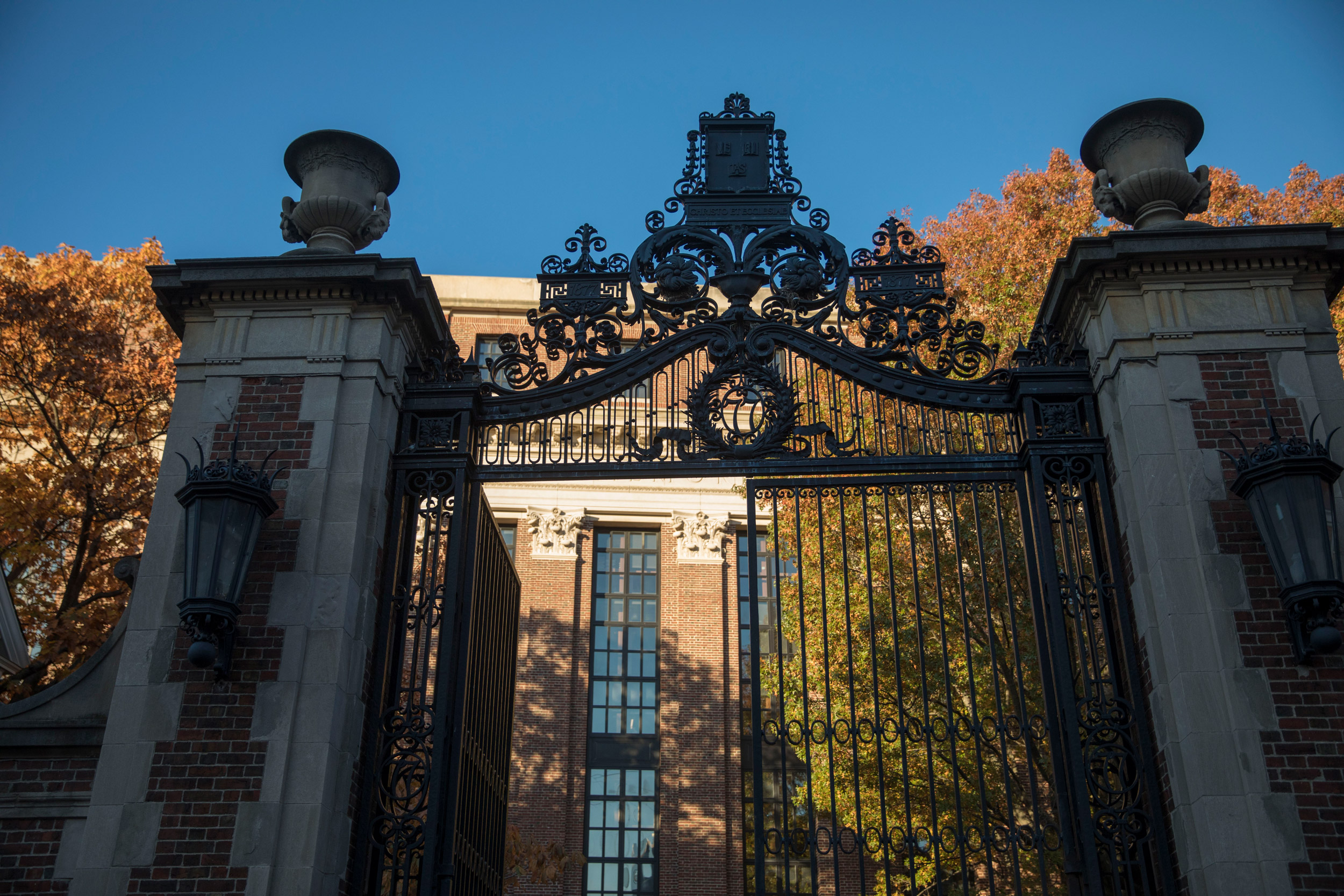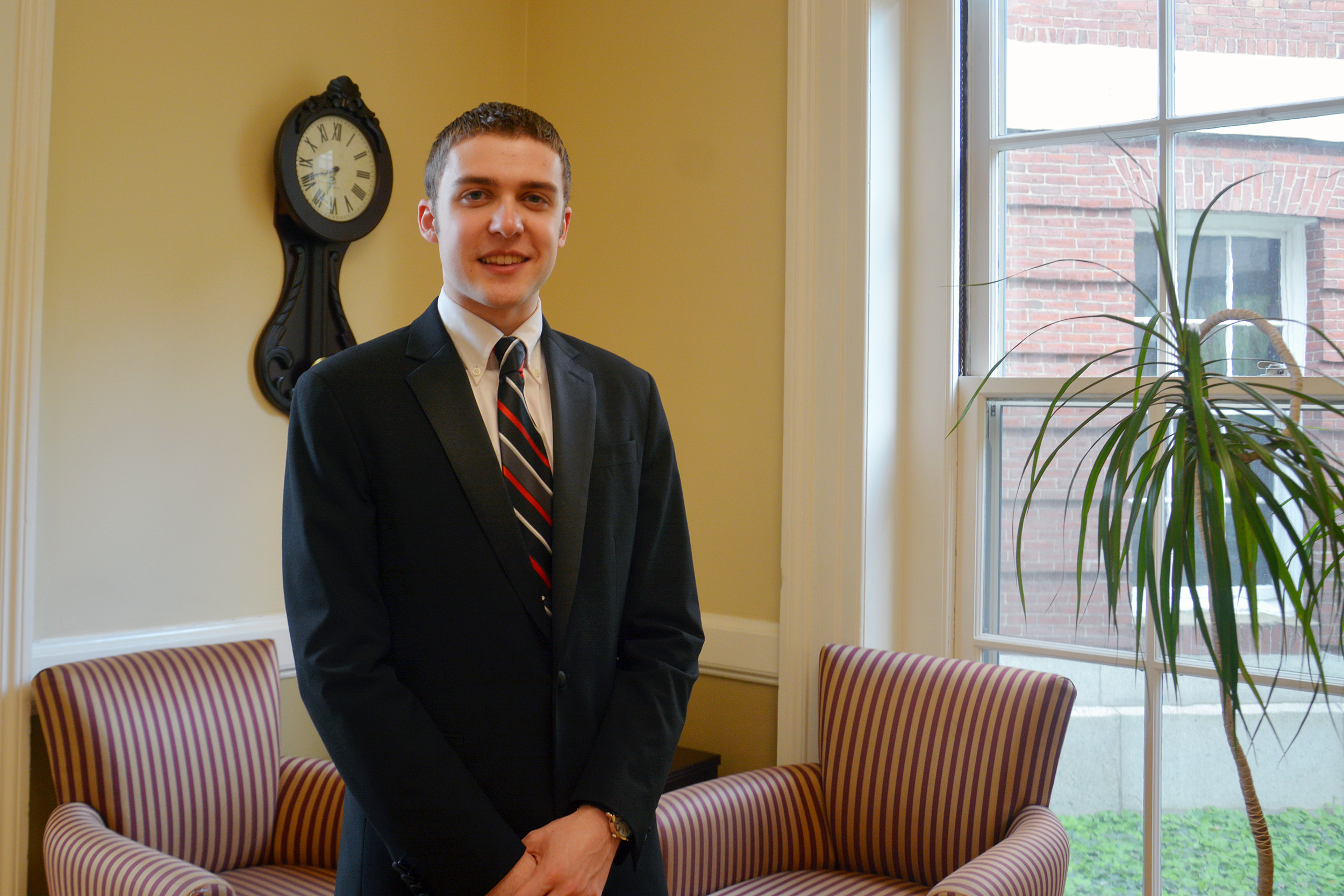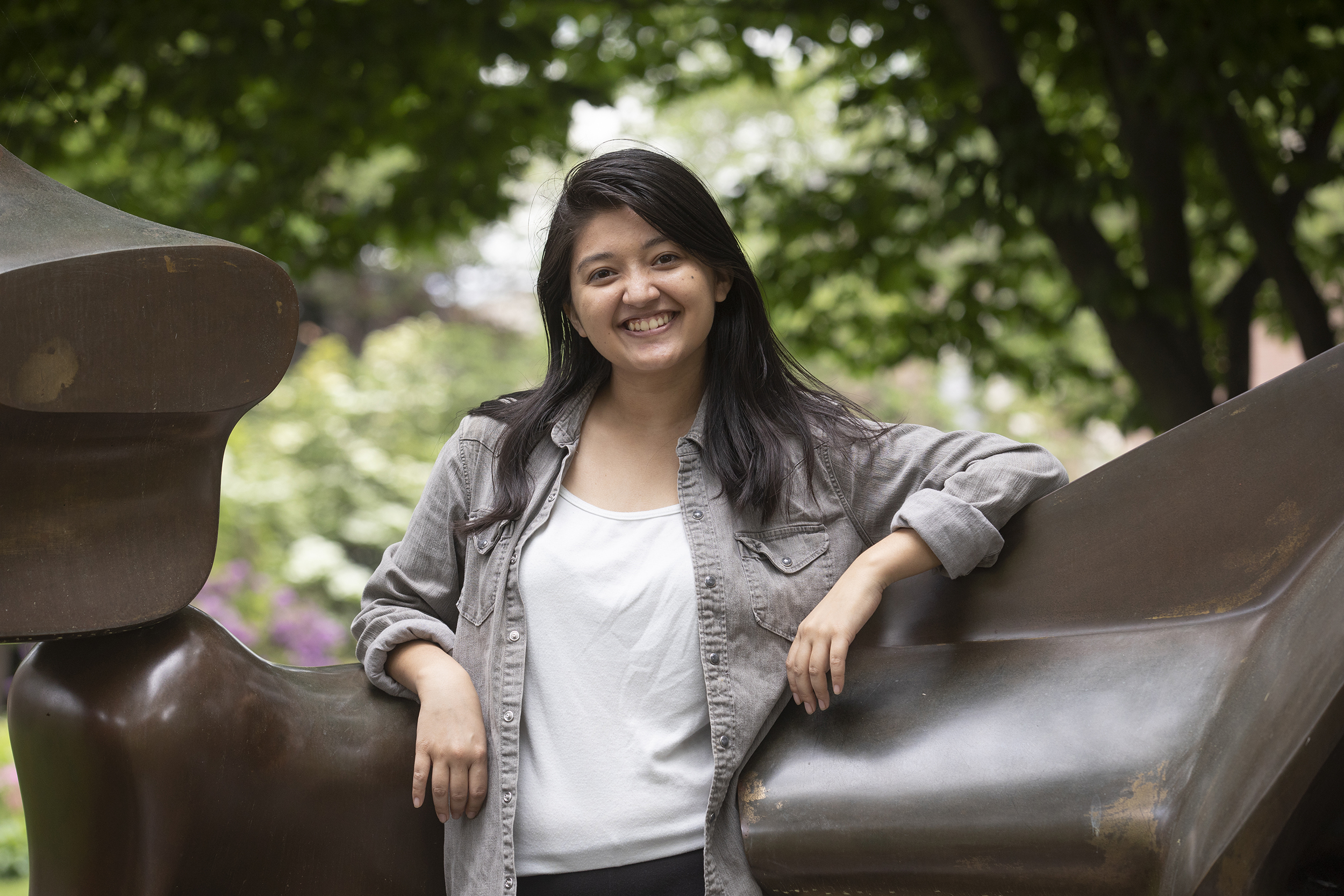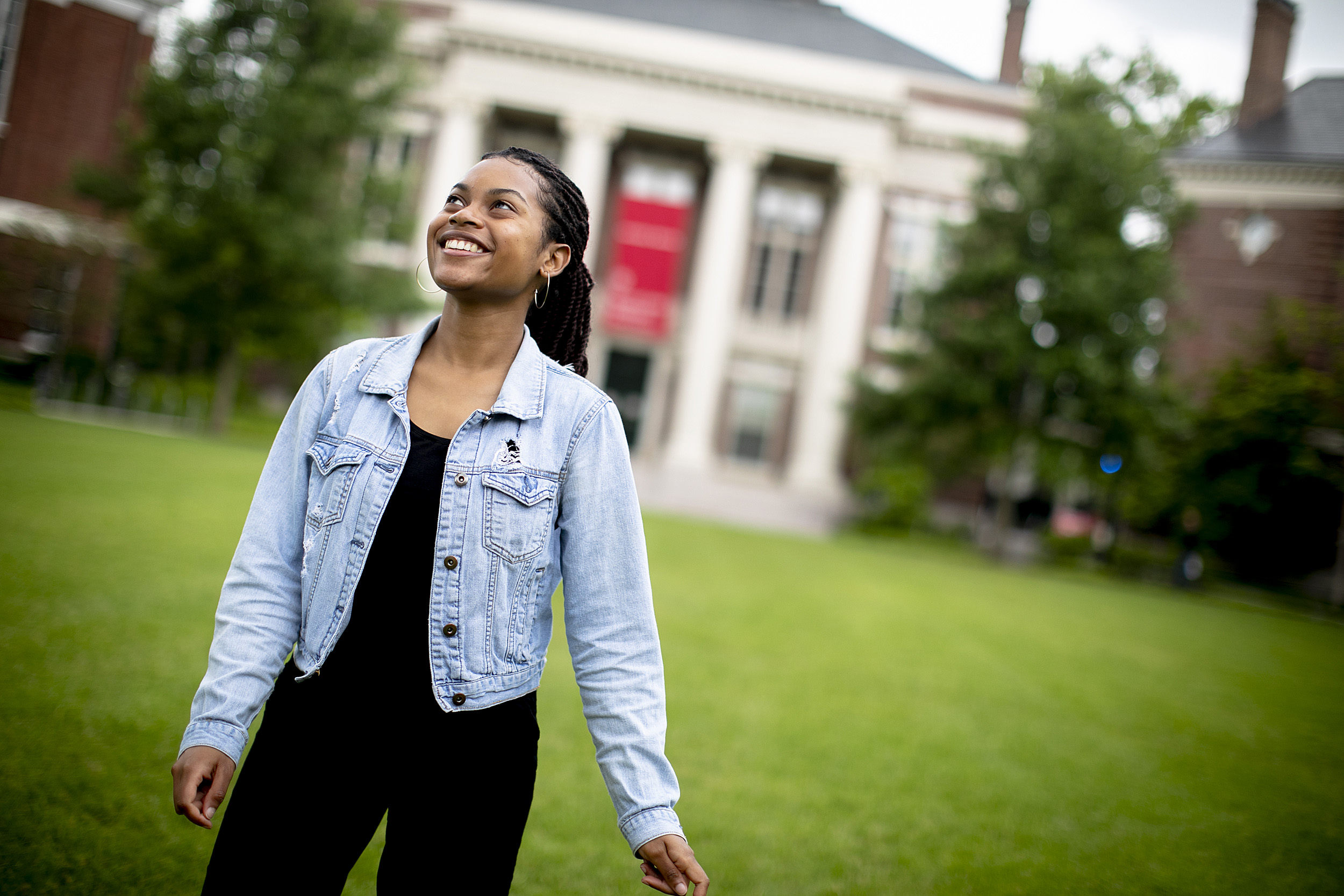
Harvard’s Financial Aid Initiative is opening doors to students regardless of income.
Kris Snibbe/Harvard file photo
Leveling the playing field
Harvard’s expansive financial aid program ensures diversity by welcoming freshmen regardless of their circumstances
This is the fifth and final installment in Learning from Difference, a series on diversity at Harvard.
When Brandon Buell applied to Harvard, he expected to be rejected. But here’s the twist: He got in.
“I wanted to apply to one school that seemed like a real reach just so I could get rejected, move on to some other school, and never have to wonder ‘What if?’” said Buell ’20. “Harvard wasn’t even on my radar. I don’t think it was until I was accepted that I truly considered Harvard a possibility.”
Often, though, getting into college and paying for it are two very different challenges, particularly for a kid like Buell, whose parents are factory workers and whose grandparents were dairy farmers.
But that’s where Harvard’s Financial Aid Initiative (HFAI) comes in.
Announced by then-President Lawrence Summers in 2004 and later expanded under President Drew Faust, HFAI was intended to open the College’s doors to exceptional students regardless of their economic backgrounds by providing grant aid to support — or in some cases cover the full cost of — attending Harvard for students from low-income families.
For Buell, who grew up in a small, upstate New York town of fewer than 5,000 people and was one of just 28 students in his high school graduating class, that changed the game.
“One of the primary reasons I came here was because the aid I received was far beyond what any other school gave me,” said Buell, a Leverett House resident and applied math and statistics concentrator. “There were schools giving me full-tuition merit scholarships, but I would have ended up paying more there than if I came here.”
“One of the primary reasons I came here was because the aid I received was far beyond what any other school gave me,” said Brandon Buell. “There were schools giving me full-tuition merit scholarships, but I would have ended up paying more there than if I came here.”
Courtesy of Brandon Buell

While the initiative’s impact on students’ lives can be hard to overstate, Buell said its effects aren’t limited to the balance sheet.
“One of them is the idea that this is an institution that belongs to you,” Buell said. “There is a connotation of Harvard as a bastion of wealth and elitism. If you feel like maybe you don’t belong here, that can stop you from wanting to snap up that acceptance letter. HFAI and the financial aid office do a great deal of work with low-income students to make Harvard feel much more inclusive.
“But there is also just the fundamental question of ‘Can I afford this?’” he added. “HFAI has dismantled the financial obstacles to coming here.”
That dismantling, Griffin Director of Financial Aid Sally Donahue said, was among the initiative’s goals from the beginning.
By opening the College’s doors to exceptional students regardless of their family incomes, the initiative has brought to campus new diversity — both racial and economic — and has created opportunities for students from a wide range of backgrounds to interact and learn from one another.
Since the start of the initiative, “We’ve seen about a 30 percent increase in the number of low-income students in the College,” Donahue said. “Over 16 percent of the Class of 2022 are first-generation students. Those changes are largely the result of our enhanced financial aid program, and have changed the face of the College.
“Everyone benefits from this increased socio-economic diversity in the classroom and beyond. All members of the Harvard community have to grow and listen to points of view that are very different from their own, and this has enhanced our collective understanding of what it means to be an educated citizen.”
Though financial aid for students has been part of Harvard’s educational model from the start — the College’s first scholarship was awarded in 1643 — the HFAI program takes the notion of providing aid to students and runs with it.
“Intelligence, leadership, and talent don’t fall along economic lines, and we want to be sure our doors are open to young people from across the globe.”
Sally Donahue, Griffin Director of Financial Aid
“The initiative was launched as a call to action for institutions of higher education to make sure they continued in the important societal role of being engines of opportunity for young people,” Donahue said. “We did a great deal of research to make sure we were reaching all talented students who might think of Harvard as an opportunity, and we actually came to the conclusion that we weren’t.”
That realization, she said, led to the initiative and to new efforts to make sure that students around the world understood that Harvard was within their reach.
“We wanted to deliver a clear message that Harvard’s doors are open to all talented students, so … what we said when we launched HFAI in 2004 was that if your family makes less than $40,000 a year, we will not ask them to contribute to the cost of your education,” she said. “We wanted to be simple and transparent and encourage young people to apply to Harvard, to assure them they would be considered on the merits of their achievements, without regard for their family’s ability to pay.”
Two years after the initiative was launched, the income ceiling at which families pay nothing for the cost of a Harvard education was increased to $60,000, and in 2011 it was increased again, to $65,000. In addition, families with incomes between $65,000 and $150,000 contribute from zero to 10 percent of their income.
“Access and affordability, enabled by generous financial aid, are fundamental to Harvard’s identity and excellence,” Harvard President Drew Faust said in 2011 in announcing expansion of the aid program. “We admit students without regard to their financial need, and we make sure that they are given the means to attend and take advantage of the Harvard College experience. This is a bedrock commitment.”
“It felt unreal,” said Ahilya Khadka. “You hear things about how expensive college is all the time, but to get into my dream school, and then to see the financial aid offer, I said to myself, ‘Oh my God, this is real.’”
Jon Chase/Harvard Staff Photographer

That commitment has led to a dramatic growth in funding for aid, from $80 million in 2005 to more than $190 million today. During this time, more than $1.8 billion in need-based scholarships has been awarded though the program.
The initiative quickly became so deep a part of the Harvard experience that when the international financial crisis struck in 2008, Faust and Edgerley Family Dean of the Faculty of Arts and Sciences Michael D. Smith made it a point to protect it from budget cuts.
“At the time I felt strongly, and I still do feel, that we had to find a way to continue to fund that, and to keep that program headed in the right direction,” Smith said. “We had done a tremendous amount to invest in financial aid and have it truly help talented students realize that they could come to Harvard and take advantage of the opportunities we have here, and not be held back because of their family’s particular financial circumstances. It was having such a huge impact on our students and the kinds of talent we were bringing here that it was clear we didn’t want to interrupt that in any way.”
Five years later, Faust and Smith again made student aid a priority in Harvard’s capital campaign, drawing significant philanthropic attention to the issue, perhaps most notably in the form of Kenneth C. Griffin AB ’89.
In 2014, Griffin made the largest gift in Harvard College history — more than $125 million — principally focused on supporting Harvard’s financial aid program. When announcing the gift, Griffin, founder and CEO of Citadel LLC, cited the importance of breaking down barriers to education.
“The greatest legacy I can leave behind is for Harvard to open its doors to everyone who’s qualified to go there,” he said at the time. “Simply put, my Harvard experience changed my life. My hope is that with this gift we will make it possible for the best and brightest in our nation and in our world to have the same experience that I had at Harvard.”
That generosity, Donahue said, has extended across the country and even around the globe.
Roughly 12 percent of the Class of 2022 is composed of students from outside the country.
“Another thing that is unusual about Harvard,” Donahue said, “is that we are able to fully extend our financial aid to admitted students from countries all over the world. As a result, we have a very different international student population than many other colleges and universities. Intelligence, leadership, and talent don’t fall along economic lines, and we want to be sure our doors are open to young people from across the globe.”
One such young person is Ahilya Khadka ’19, who emigrated from Nepal to Iowa at age 16.
“I went to an all-girls Catholic school in Kathmandu through 10th grade,” Khadka said. “But the main reason my parents decided to move to the U.S. was for the educational opportunities. Nepal has schools through secondary school, but after that it’s not as specialized, so a lot of students move to the U.S. for college.”
“Everyone benefits from this increased socio-economic diversity in the classroom and beyond. All members of the Harvard community have to grow and listen to points of view that are very different from their own, and this has enhanced our collective understanding of what it means to be an educated citizen.”
Sally Donahue, Griffin Director of Financial Aid
While Khadka knew she wanted to attend college, for most students at her high school that meant perhaps Iowa State or the University of Iowa, not faraway Harvard.
“Out-of-state schools aren’t really on the radar unless someone from your family went there,” she said. “But I wanted to see what Harvard was like … so I did a lot of research on the website. If you asked me where anything was on the site, I could tell you, because I read that site thoroughly.”
While Khadka earned top grades in high school, the notion of attending Harvard didn’t feel as though it was in reach until she stumbled on a video about Lucerito Oritz ’10, a student from California who had received aid.
“Just seeing that story made me realize that maybe I could afford this,” she said. “I went online and checked the net price calculator, and that was when I found out my parental contribution would be zero.
“It felt unreal,” she added. “You hear things about how expensive college is all the time, but to get into my dream school, and then to see the financial aid offer, I said to myself, ‘Oh my God, this is real.’”
As Harvard’s doors open wide to students from increasingly diverse backgrounds, Khadka, a Cabot House resident and social studies and statistics concentrator, said that it’s natural to see that shift reflected across campus and in classrooms.
“Last semester, I took a class called the Economics of Education,” Khadka said. “And as we talked about the different aspects of education here in the U.S., what was interesting was that no single person in the class had the same experience. There were students who had gone to private schools, students from public schools, and students who had qualified for Head Start programs.
“Whereas before you might only read about something in a paper, students in the class were able to give real-life insights,” she continued. “So the diversity in terms of socio-economic status has really transformed the classroom dynamics in some ways as well.”
For new graduate Alicia Hamilton ’18, coming to Harvard was in many ways the culmination of her parents’ efforts to instill in her the importance of education.
“I thought it was a joke at first,” said Alicia Hamilton when she heard Harvard’s financial aid offer. “My family was prepared to take out hundreds of thousands of dollars in loans. … You can’t put into words the blessing that it is.”
Rose Lincoln/Harvard Staff Photographer

Growing up in Kingston, Jamaica, Hamilton remembers her father picking her up from school every day and taking her to the travel agency he managed, where he would make sure she and her sister were conscientious about completing their homework.
“Because he didn’t have a college education, my father went from managing a travel agency to working the front desk at a car rental agency,” said Hamilton, an Eliot House resident and history concentrator. “But even when he was working crazy hours, he always made it a priority to wake up in the morning and walk me to school, and still made sure that my homework was completed.”
And as incredible as it felt to be accepted, knowing that not only would she be able to afford to attend Harvard but would graduate debt-free was beyond imagining. Hamilton will spend the next year teaching 11th-grade U.S. history in California as part of the third cohort of Harvard Teacher Fellows through the Graduate School of Education, with a goal of getting her license to teach in Massachusetts and working toward a master’s in education.
“I thought it was a joke at first,” when she heard Harvard’s financial aid offer, she said. “My family was prepared to take out hundreds of thousands of dollars in loans for me to have this Harvard experience, so being able to attend what many people would consider the top university in the country for less than it would cost to attend community college, it’s not something you can wrap your mind around. You can’t put into words the blessing that it is.
“For me, the Harvard Financial Aid Initiative has made Harvard a place of hope,” she said, reflecting on how it has changed the campus. “Harvard has become an attainable place of hope — somewhere people can invest their dreams in. It’s diversity in its truest form.”




